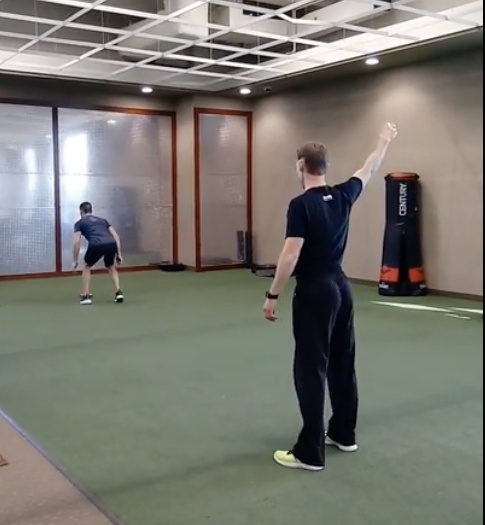Base Rotation to Retreat
By: Phil Loomis
There are certain movement skills that permeate the sports landscape. One such movement skill is what I refer to as a base rotation to retreat. This movement allows athletes to reposition their base (lower half/hips down to feet) to allow a more efficient retreating acceleration while maintaining ‘vision’ of the developing play in front of them.
Think of
- a tennis player getting back on a lob,
- a short stop chasing down a fly ball heading toward short centerfield,
- a free safety in football that has to honor a potential run fake then has to retreat to cover a tight end running free down the hashmarks, or
- a defender in basketball that quickly needs to reposition and cut off an explosive wing that just crossed him up…
In all of these situations the athlete needs to see the play develop and then ‘explode’ in order to cover the ground necessary to make a play.
Related: Drive and Drop Start Technique
The beautiful thing about this movement skill is that well exposed (physically literate) athletes will execute it reflexively! Why? Simply, it’s the most efficient way to ‘get back’ and make a play. As movement coaches we do need to be aware of it. If the base rotation to retreat is not being executed by the athlete in the proper context, we need to recognize it and create opportunities for athletes to experiment with it until they innately resort to it under duress.
I assess for the base rotation to retreat in my initial coaching session with an athlete. To do this, I put them in a position that forces them to react. I want to observe what movement pattern they resort to. If they already do it well, no need to break it down part by part! They already have it downloaded.
Two assessments that I use to draw this skill out:
Rear facing ball drop
Rock-Paper-Scissors
The rules for this are pretty simple. Two athletes stand across from each other behind a designated line (in the video I tipped cones on their side and athletes had to start with both feet behind the base of the cone). The athlete that ‘wins’ (example: paper beats rock) chases and the athlete that ‘loses’ has to retreat and pass over a designated line or cone before they are tagged. I usually play first one to 5 points. You earn points when you pass the line before being tagged or tagging the opponent before they pass the line. Athletes compete hard on this and have a ton of fun! At the same time as a coach you get to observe their athletic instincts ‘under fire’.
In the case of an athlete who does not execute the skill well I will take them through the following sequence:
Base rotation- static predictable>static random> dynamic predictable>dynamic random
In this video I introduce the skill and demonstrate the above progression:
Adding intent to the movement: Even athletes that do it well will benefit from the following drills:
Band resisted
The use of elastic/rubber bands allows the athlete to feel the plyo step. The band also ‘holds them up’ and slows the movement down so the athlete can feel what should be an explosive push off.
Rear facing med ball toss and chase
This drill allows the athlete to create force into the ground and transfer it through the upper body at ball release. The chase part of the drill drives home the ‘get off this spot’ intent. I want the athlete to explode that ball into the wall and go get it. (1st video is posterior view and 2nd video is side/lateral view)
Adding a reactive element:
I like to put athletes in a position to react as they would in a competitive setting. The 2 drills I use to assess the base rotation to retreat (rear facing tennis ball drop, Rock-Paper-Scissors) fit the bill for this purpose.
The Simple Checklist Coach Lee Taft uses to teach acceleration: Get Your Checklist Here
Coaching keys:
Throughout all of the above examples I want to see the athlete ‘stay in the tunnel.’
‘Raising up’ will dissipate the ability of the athlete to execute an explosive retreat acceleration.
Another “seed” that I want to plant in the head of the athlete is to not snap the head around too quickly. The intent of this skill is to keep the play in front of you and see it develop. After they have diagnosed the play and it requires them to completely turn their body to run, then they can snap the head and shoulders around. To combat this upon execution of the skill I will hold up both hands and flash numbers with my fingers and the athlete has to call out the number before they can turn and go.
Upon execution of the base rotation to retreat the athlete should cover ground with a very direct path in the intended direction of travel! Many athletes will drop step and pivot or they will spin out with a wide turn before retreating. In both cases they won’t cover any ground and in the latter case will actually lose ground. In the rear facing ball drop video, the first two athletes in the video resort to these two very inefficient movement options.
Cues:
Get off this spot as fast as you possibly can!
Explode as far away as possible with one push!
 About the Author
About the Author
Coach Phil Loomis is a fitness professional and nutrition coach at Life Time Athletic in Bloomfield, MI as well as a strength and conditioning coach for the Michigan Red Sox in Birmingham, MI. He was also the head coach and CEO of Forever Fit in Troy, MI. He is currently certified as a Strength and Conditioning Specialist, Youth Athletic Development Specialist, Speed and Agility Specialist, Corrective Exercise Specialist, and a Precision Nutrition Certified Coach among others.
Coach Loomis played Division 1 college baseball and it was then that he developed the appreciation for the impact that off-field performance training and nutrition can have for developing athletes. His passion for youth and sports performance lead him to start Forever Fit. His training experience has lead him to develop a deep appreciation for corrective exercise and long-term athletic development strategies. He specializes in functional anatomy and bio-mechanics as they relate to program design and corrective exercise; youth athletic development; and rotational/overhead athlete performance enhancement.
Recommended Athletes Acceleration Products
 | |
| Complete Program Design |



0 Comments for “Base Rotation to Retreat”